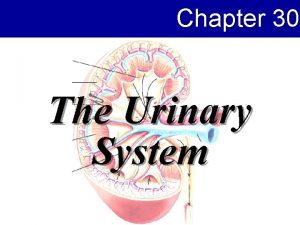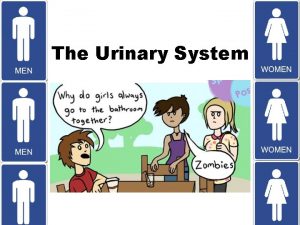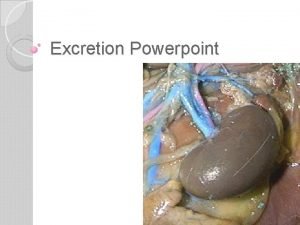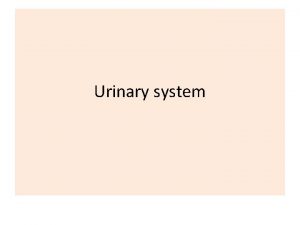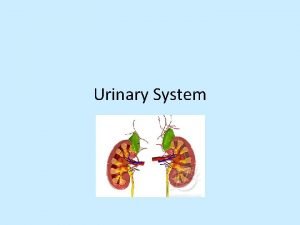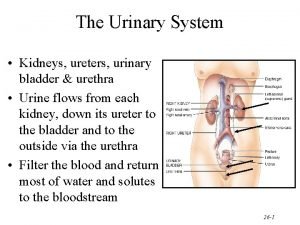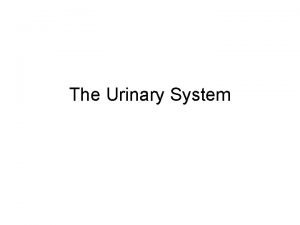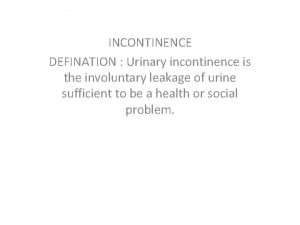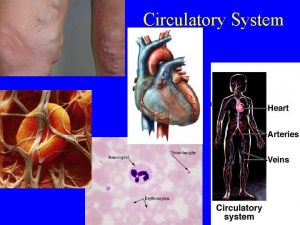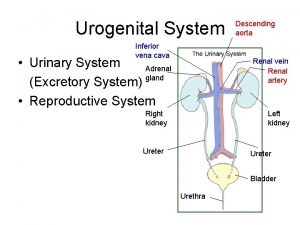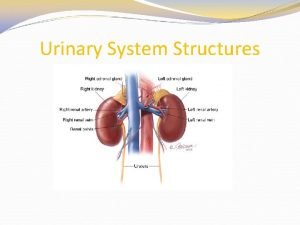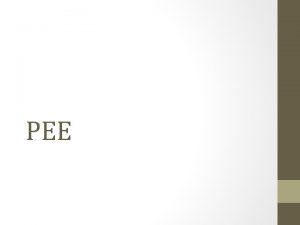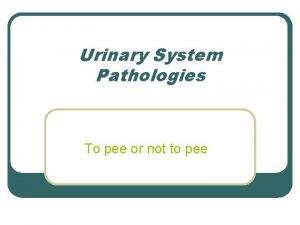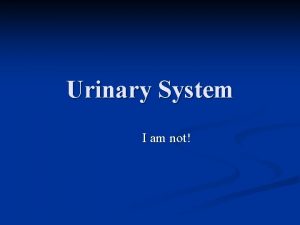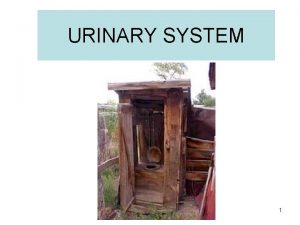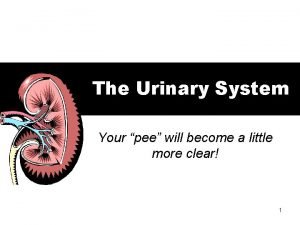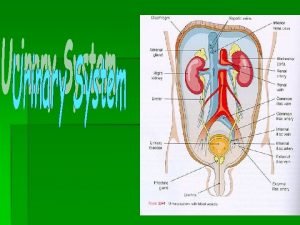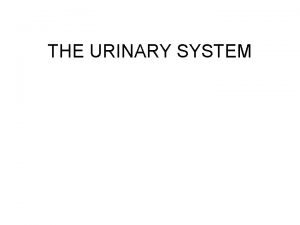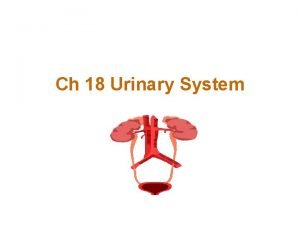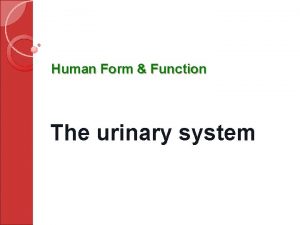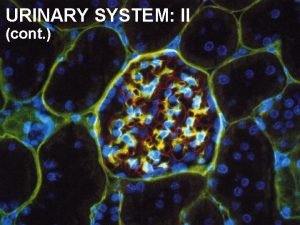Urinary System To pee or not to pee
























- Slides: 24

Urinary System To pee or not to pee

Preview Functions: Eliminate nitrogenous wastes, toxins, and drugs Regulates the blood’s volume and chemical make up-water/salts and acids/bases The urinary system rids the body of nitrogenous wastes while regulating water, electrolyte, and acid-base balance in the blood.

Preview Organs: Kidneys Ureters Urinary bladder Urethra Lungs Skin Urinary system

KIDNEYS Located in the superior lumbar region, against the dorsal body wall. Functions: Manufacture urine Produces renin: regulates blood pressure Produces erythropoietin: stimulates red blood cell production Converts vitamin D to its active state

KIDNEYS Outer Structures: Renal hilum: medial indentation, ureters, renal blood vessels, and nerves Capsule: fibrous sac surrounding kidneys Fat surrounding kidneys: holds kidneys in place lose itkidneys may drop (ptosis), kinking ureters urine to back up and increase the pressure in the kidney (hydronephrosis)

KIDNEYS Inner Structures: the 3 layers Renal cortex: outer region Renal medulla: middle region Renal pyramids: triangular regions of medulla, drains urine Calyces: cup-shape area that enclose tips of pyramids, collects urine Renal pelvis: innermost region, ureters exit from here

Urinary System

Did You Get It? 1. What are the functions of the Excretory system? 2. What are the functions of the kidneys? 3. Jane lost lots of weight, and suddenly she was having problems with her urine flow. What would you guess happened, AND what caused the problem? 4. From the most superficial aspect of a kidney to its ureter, name three major regions.

Nephrons The filtering units of the kidneys are the nephrons. The nephrons are located within the cortex and medulla of each kidney. The tubes of the nephron are surrounded by cells and a network of blood vessels spreads throughout the tissue. Therefore, material that leaves the nephron enters the surrounding cells and returns to the bloodstream by a network of vessels.

Parts of the Nephrons Each nephron consists of the following parts: 1) glomerulus-Network of small capillaries leading into nephrons 2) Bowman’s capsule-waste products are forced out of capillaries 3) proximal convoluted tubule-beginning of the nephron 4) loop of Henle-removes water 5) distal convoluted tubule 6) collecting duct.

Parts of the Nephrons Put the following parts in correct order (blood into kidneysblood and urine exit kidney): Bowman’s capsule Ureters Collecting duct Renal vein Distal tubule Renal artery Glomerulus Proximal tubule Loop of Henle

How the kidney does its job!

How the kidney does its job! • • Kidney Action Blood enters Bowman’s capsule through the renal artery. The artery branches to form a glomerulus. Blood pressure forces some blood plasma and small particles into the surrounding capsule — (this is called the nephric filtrate). • Large particles such as blood cells and proteins remain in capillaries. • The nephric filtrate is pushed out of the capsule and into the proximal convoluted tubule. • This is where reabsorption begins.

How the kidney does its job! Only materials needed by the body are returned to bloodstream — for example, 99 % of water, all glucose and amino acids and many salts are reabsorbed. Osmosis , diffusion, and active transport draw water , glucose , amino acids and ions from filtrate into surrounding cells. Small villi like projections help in the active transport of glucose out of the filtrate and speed up the reabsorption process. From here, these components return to the bloodstream. The filtrate reaches the end of the proximal tubule and the fluid is isotonic with the surrounding cells. Glucose and amino acids have been removed from the filtrate. The filtrate then moves to the loop of Henle whose primary function is to remove water from the filtrate by osmosis.

How the kidney does its job! There is an increase in sodium concentration in the cells of the loop of Henle as we move from the area of the cortex to the inner pelvis of the kidney. This causes water to be drawn from the filtrate. These high levels of sodium are a result of active transport and results in increased concentration of filtrate (due to water loss).

Why doesn’t water on outside go back in? The water that left the descending loop cannot enter the ascending loop because it is impermeable to water. As the water concentration in the filtrate decreases, the chlorine concentration increases and causes it to diffuse out of the tubule. This process is helped by the electrical attraction of chlorine to sodium. The filtrate moves to the distal convoluted tubule where tubular secretion occurs. Active transport is used to pull hydrogen ions, creatinine, drugs such as penicillin out of the blood and into the filtrate. Fluid from a number of nephrons moves from the distal tubules to a common collecting duct which carries what can now be called urine to the renal pelvis.

Disorders of the Excretory System Our excretory system is very important in maintaining homeostasis. There are certain conditions which can affect the excretory system. We will discuss some of these common disorders.

Disorders of the Excretory System Urinary Tract Infection (UTI) Is a very common disorder. If the bladder has become infected, it is known as cystitis. If the urethra is infected. , it is called urethritis. UTI is more common in women than men because of differences in anatomy. Symptoms include painful urination burning sensation), frequent urination (even if no urine present) and bloody or brown urine. This can lead to chills, fever, nausea, vomiting and upper abdomen tenderness.

Disorders of the Excretory System Kidney Infections Result when an infection reaches the kidneys and becomes known as pyelonephritis. Common causes can be infection from elsewhere in the body or obstruction of the prostate gland (usually in older men). For children, infection can be caused by the tube that drains urine from the kidneys and the bladder. If left untreated, all UTI’s can lead to permanent kidney damage and possible kidney failure. The general treatment is by antibiotics. A person needs to maintain good personal hygiene when eliminating wastes (liquid and solid forms) from the body. Also, a person should drink lots of water.

Disorders of the Excretory System Kidney Stones Are also a common kidney disorder. They form when chemicals in the urine precipitate out and form crystals. The most common crystals are from calcium oxalate, while others could be from uric acid and cystine. Kidney stones are more common in men than women and can reoccur at any time. Factors such as recurrent urinary bladder infections, insufficient water intake and consumption, low levels of physical activity, and too much Vitamin C and D intake can lead to kidney stones. One of the best ways to decrease the occurrence of stones is to drink lots of water and to change your dietary habits.

Disorders of the Excretory System Kidney Stones (cont) Symptoms include severe back or abdomen pain, blood in the urine, nausea and vomiting. Diagnosis involves a complete medical examination, including X-rays. Treatment may vary from letting the stones pass through the urinary tract to ultrasound shock (or lithotripsy) to disintegrate the stones to a small size that can be passed through the urinary tract. Real large stones require surgery for removal.

Ureters, Urinary Bladder, & Urethra Ureters are the tubes which deliver urine to the urinary bladder from the kidneys via peristalsis Urinary Bladder is a smooth, collapsible muscular sac that stores urine. holds 500 ml - 1000 ml Urethra is the tube that carries urine from bladder to outside the body. internal urethral sphincter (involuntary) external urethral sphincter (voluntary) length differs between the sexes Micturition is the emptying of bladder Incontinence is the inability to voluntarily control the external

KIDNEY TRANSPLANT-Talking Chips Anyone starts the conversation by putting down their ruler. Continue the conversation by putting down your ruler. Cannot talk if your ruler is on the table, cannot pick up your ruler until ALL have participated When ALL rulers have been put down, collect and continue in the same manner. .

KIDNEY TRANSPLANT-Talking Chips 1. What criteria should be used to determine the best recipient of the kidney? a. THINK TIME b. START 2. Who do you feel the kidney should go to? Justify your selection. a. THINK TIME b. START.
 Red and white blood cells difference
Red and white blood cells difference Not genuine, not true, not valid
Not genuine, not true, not valid Urinary system introduction
Urinary system introduction Glomerular filtration
Glomerular filtration Ur medical terminology
Ur medical terminology Urinary system facts
Urinary system facts Fetal pig excretory system diagram
Fetal pig excretory system diagram Chapter 30 the urinary system workbook answers
Chapter 30 the urinary system workbook answers Kidney pyramid labeled
Kidney pyramid labeled Chapter 20 urinary/excretory system
Chapter 20 urinary/excretory system Urinary system model
Urinary system model Urinary system fun fact
Urinary system fun fact Osteichthyes
Osteichthyes Urinary system powerpoint
Urinary system powerpoint Urinary system also known as
Urinary system also known as Functions of adh
Functions of adh Renal corpuscle
Renal corpuscle Figure 15-4 is a diagram of a nephron
Figure 15-4 is a diagram of a nephron Prone
Prone Defination of urine
Defination of urine Homework
Homework External anatomy of a rat
External anatomy of a rat Rat urinary system
Rat urinary system Vena cava function in excretory system
Vena cava function in excretory system Diagram of the renal system
Diagram of the renal system







